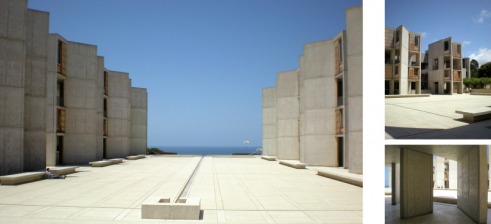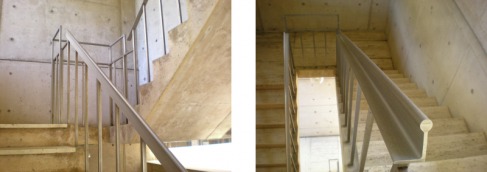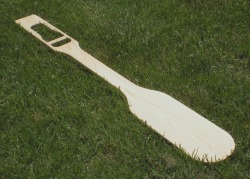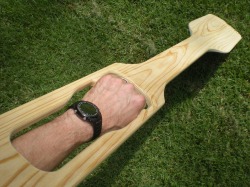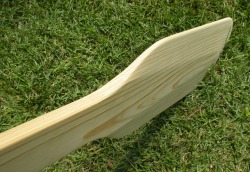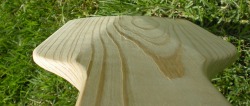[Jennifer] For those of you dying to know the answer to last week's "What's It?"... The photo is a detail of a stairwell at the Salk Institute for Biological Studies in La Jolla, California, designed by architect Louis I. Kahn, constructed from 1960-1966. You might recognize some other views of this project:
In the original post, Adan's hand is on the handrail/guardrail. The entire rail is fabricated of stainless steel – that's part of why it's looking so great even though it's been exposed to sea air for the past 45-50 years. (Kudos go to David for noticing a slight amount of rust forming on the steel. Extra points for your optimism that something non-brick could be possible at UVa.) The toprail element is a custom fabrication of extruded stainless steel. If you look closely, you'll see that it's similar to a standard structural shape known as an angle used in many applications in building construction (brick lintels, &c.). My guess is it's an L3x5 modified to have a +/- 1" diameter round bulb flaring from the top flange. It's sized such that your hand fits around the top curve nicely. The shape is strong enough to provide the required structural support for the guardrail, and the custom profile allows it to function as a handrail; it's both in one. It's an elegant move and an excellent example of the economy of means architects and designers struggle to achieve.
This was a custom fabrication job. The shape has a consistent cross-section, meaning it likely was fabricated as an extrusion of stainless steel drawn through a die. Custom extrusions can be prohibitively expensive, but become more achievable if you're making a lot of that custom shape. The design team that developed this detail knew they could use this shape as the handrail on every stair throughout the project. Also, it seems as though they had an amazingly supportive patron and client in Dr. Jonas Salk.
This was a custom fabrication job. The shape has a consistent cross-section, meaning it likely was fabricated as an extrusion of stainless steel drawn through a die. Custom extrusions can be prohibitively expensive, but become more achievable if you're making a lot of that custom shape. The design team that developed this detail knew they could use this shape as the handrail on every stair throughout the project. Also, it seems as though they had an amazingly supportive patron and client in Dr. Jonas Salk.
You can learn more about Lou Kahn in the documentary "My Architect," made by his son, Nathaniel Kahn. Nerds can learn more about the technical details in the book Louis I. Kahn: Building Art, Building Science, by Thomas Leslie.
BTW, Adan says "Hi." He misses posting blog updates, but he's busy bringing more power to the electrified baritone ukulele and other fun stuff in development here. Cheers, all.
BTW, Adan says "Hi." He misses posting blog updates, but he's busy bringing more power to the electrified baritone ukulele and other fun stuff in development here. Cheers, all.
